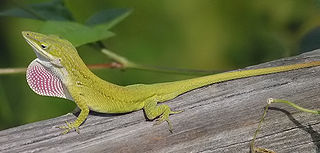
Dactyloidae are a family of lizards commonly known as anoles and native to warmer parts of the Americas, ranging from southeastern United States to Paraguay. Instead of treating it as a family, some authorities prefer to treat it as a subfamily, Dactyloinae, of the family Iguanidae. In the past they were included in the family Polychrotidae together with Polychrus, but the latter genus is not closely related to the true anoles.

Anolis is a genus of anoles, iguanian lizards in the family Dactyloidae, native to the Americas. With more than 425 species, it represents the world's most species-rich amniote tetrapod genus, although many of these have been proposed to be moved to other genera, in which case only about 45 Anolis species remain. Previously, it was classified under the family Polychrotidae that contained all the anoles, as well as Polychrus, but recent studies place it in the Dactyloidae.

The brown anole, also known commonly as the Cuban brown anole, or De la Sagra's anole, is a species of lizard in the family Dactyloidae. The species is native to Cuba and the Bahamas. It has been widely introduced elsewhere, via the importation and exportation of plants where the anole would lay eggs in the soil of the pots, and is now found in Florida and other regions of the United States including southern Georgia, Texas, Louisiana, Tennessee, Mississippi, Alabama, Hawaii, and Southern California. It has also been introduced to other Caribbean islands, Mexico, and Taiwan.

Anolis roosevelti, also known commonly as the Virgin Islands giant anole, Roosevelt's giant anole or the Culebra giant anole, is an extremely rare or possibly extinct species of lizard of the genus Anolis in the family Dactyloidae. The species is native to the Virgin Islands and Vieques.

Anolis pulchellus, the Puerto Rican anole, Puerto Rican bush anole, snake anole, or sharp-mouthed lizard, is a small species of anole lizard in the family Dactyloidae. The species is among the most common lizards in Puerto Rico, and also native to Vieques, Culebra, and the Virgin Islands.
Plasmodium azurophilum is a species of the genus Plasmodium. Like all species in this genus it is a parasite of both vertebrates and insects. The vertebrate hosts are anole lizards.
Guana Island is an island of the British Virgin Islands (BVI) in the Caribbean. One of the few remaining privately owned islands in its part of the world, Guana has seven white powder-sand beaches and 850 acres (3.4 km2) of tropical forest, mountains, hills, and valleys. The island is mostly natural preserve and has a small resort.

Anolis cristatellus is a small species of anole, belonging to the Dactyloidae family of reptiles. The species is native to Puerto Rico and the U.S. and British Virgin Islands, with introduced populations in locations around the Caribbean. The males of A. cristatellus are easily recognizable by the fin running down the top of the tail, which is known as a "caudal crest". The females also have this crest, but it is smaller than that of the males. The species is often quite common in many areas on Puerto Rico, where it can be seen during the day passing the time on the lower parts of tree trunks, or on fences and the walls of buildings in urban areas, sometimes venturing down onto the ground in order to lay eggs, have a snack, or do other cursorial activities. Like many anoles, this species displays the characteristic behaviour of doing push-ups as well as inflating a pizza-like flap of coloured skin on its throat, known as a dewlap, in order to show others how dominant it is, and thus attract mates or intimidate rivals.
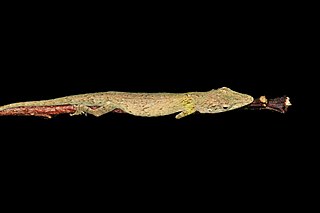
The Puerto Rican twig anole or dwarf anole is a species of small, arboreal anole endemic to Puerto Rico and primarily inhabiting the Cordillera Central from the Sierra de Cayey range in the Southeast to the central-western ranges of Maricao. A mostly grey to olive-brown bodied lizard, A. occultus is the smallest of the Puerto Rican anoles with a snout to vent length of 34–42 mm. In comparison to other twig anoles, A. occultus is extremely cryptic through its unique sleeping behaviors and mottled pattern. Sleeping behavior including site selection minimizes the probability of predator encounter along with A. occultus' extensive list of antipredator behaviors.

Anolis cuvieri is a species of lizard in the family Dactyloidae. The species is endemic to Puerto Rico, and is common in the Toro Negro State Forest.

Anolis poncensis is a species of lizard of the family of Dactyloidae. The species is endemic to Puerto Rico. It was first identified in Ponce, in the hills three miles east of the city. The Puerto Rico Department of Natural and Environmental Resources considers it a "vulnerable species".
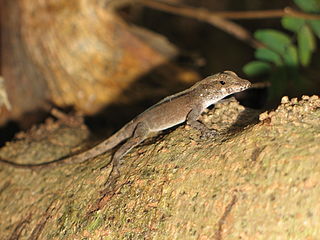
Anolis cooki, also known commonly as Cook's anole, Cook's pallid anole, and the Guanica pallid anole, is a species of lizard in the family Dactyloidae. The species is endemic to Puerto Rico.
Anolis ernestwilliamsi, also known commonly as the Carrot Rock anole, Carrot Rock's anole, and Ernest's anole, is a species of lizard in the family Dactyloidae. The species is endemic to the British Virgin Islands.
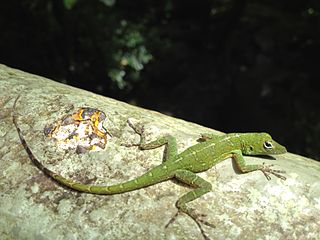
Anolis evermanni, also known commonly as the emerald anole, Evermann's anole, and the small green anole, is a species of lizard included within the family Dactyloidae. A. evermanni is native to Puerto Rico, where it is mainly found in wet forests. A. evermanni is a medium-sized lizard and bright emerald-green in color. A. evermanni is studied for its behavior as well as the evolution of the family Dactyloidae. The group of lizards which are member species of the family Dactyloidae are known as anoles. Anoles are found throughout the Americas and are related to iguanas.
There are two species of lizard named banded anole:

Anolis gundlachi, also commonly known as the yellow-chinned anole, Gundlach's anole, and the yellow-beard anole, is an oviparous, sexually dimorphic species of lizard in the family Dactyloidae. The species is endemic to Puerto Rico and lives in mountainous forests at high elevations. The diet of A. gundlachi consists mostly of insects. This species is also known for signaling other lizards through a modulated head bob display, with varying bobbing amplitudes and patterns based on an individual's distance from other lizards.

Anolis krugi, the olive bush anole, Krug's anole, or orange dewlap anole, is a species of lizard in the family Dactyloidae. The species is found in Puerto Rico.

Guilarte State Forest is one of the 20 forests that make up the public forests system in Puerto Rico. The forest is located in the eastern half of the Central Mountain Range or Cordillera Central. The main geographical feature of the forest reserve is Monte Guilarte, which is Puerto Rico's 7th highest mountain at 3,950 feet above sea level. While Monte Guilarte is located in the municipality of Adjuntas, the forest's borders also include parts of Guayanilla, Peñuelas and Yauco.
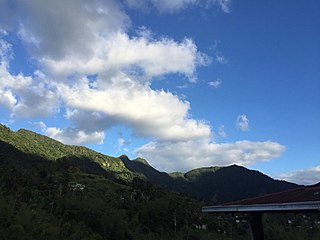
Los Tres Picachos State Forest is one of the 20 forests that make up the public forest system of Puerto Rico. The forest is located in the Central Mountain Range or Cordillera Central, along the Los Tres Picachos mountain ridge, one of the island's highest mountains, named after the distinctive three peaks of the highest mountain in the forest. The state forest is located in the municipalities of Jayuya and Ciales.

















